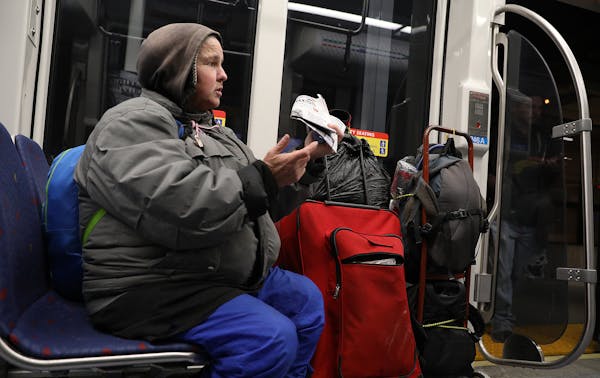A sleeping passenger sprawled across two seats of an eastbound Green Line train one early morning last week, while another dozed a few feet away, his arm slung protectively around a backpack.
It's a common scene on the light-rail line that has offered downtown service around the clock between Minneapolis and St. Paul for the past five years. But on Monday, Metro Transit was scheduled to shut down service Monday through Fridays between 2 and 4 a.m. for maintenance, offering buses as a replacement.
Social service advocates worry the scheduling switch will displace dozens of homeless people who use the train as shelter on any given night — numbers that tend to shift depending on weather and circumstance. During cold snaps last winter, the Green and Blue light-rail lines served as the second-largest homeless shelter in Hennepin County, according to one police report.
"As long as there's homelessness in this region, there's going to be homeless people using transit for shelter," said Wes Kooistra, general manager of Metro Transit.
But, he added, "Transit is not a shelter, it's not equipped. We don't have restrooms, we don't have running water, we don't offer fundamental services people need."
Homelessness is a common challenge for transit agencies, with no easy solution. It's not illegal to sleep while riding the rails, but the presence of homeless passengers may test workaday riders concerned about cleanliness and safety on the train.
A recently released report from the Minneapolis Police Department said trains running from Union Depot in St. Paul to Target Field and then to the Mall of America form a homeless camp of at least 180 to 275 people every night, depending on the weather. The number increased to about 350 people a night as temperatures dipped last winter, while another count found 431 homeless people on Jan. 23 on transit and at stations.
"Homeless people are effectively using our transit system as a homeless shelter," said Jonathan Weinhagen, president and CEO of the Minneapolis Regional Chamber of Commerce. "That's not what the system was designed to do."
Of the 22 transit agencies across the country that operate light rail, the Green Line was the only one operating on a 24-hour basis, seven days a week, which makes the line a reliable go-to for people in need.
"It's a symptom of a much larger issue,. The train is not a dignified response to it," said Cathy ten Broeke, assistant commissioner and executive director of the Minnesota Interagency Council on Homelessness. Those issues include a lack of affordable housing as well as a dearth of mental and physical health and substance abuse services.
Team response
Metro Transit has formed a Homeless Action Team to make the first contact with unsheltered riders and to build trust among them. The team consists of six police officers who try to connect homeless riders to local shelters and social service agencies, a collaboration that is seen as unique in public transit circles.
"Having individual relationships with people on the trains is really important," Kooistra said.
The team planned to be out and about early Monday morning to help homeless riders on the Green Line find shelter when service shuts down. Twenty-four-hour service will remain on Fridays and Saturdays.
Metro Transit estimated that 75 people, some of them homeless, would be aboard trains in the early morning hours Monday.
"Generally speaking, there's never enough [shelter] space," said John Tribbett, program manager for St. Stephen's Human Services street outreach team.
Homelessness in the metro area appears to be on the rise, especially those who choose "unsheltered" locations, such as cars, impromptu encampments and trains.
"Metro Transit riders are definitely part of" the growing unsheltered population, said Brian Pittman, a research scientist at St. Paul-based Wilder Foundation. "What we learned is people move around a lot. They might sleep on a friend's couch for a night, then a shelter" or the train.
Metro Transit said homeless people camping out on buses occurs less frequently because drivers generally discourage it.
A 2018 study conducted by the Wilder Foundation found homelessness has increased 10% statewide since 2015. But people forgoing a formal shelter increased 62% — rising dramatically among American Indians, African-Americans and LGBT youth. About a third of those interviewed by Wilder are employed. Most have chronic mental or physical health conditions.
Some homeless people are leery of shelter settings because of mental health or substance abuse issues. Or, they may eschew shelters because pets or some possessions aren't permitted. Overall, there's a shortage of shelter space for couples, women and families.
"We're also seeing a higher degree of situationally unsheltered, where someone might find themselves in a precarious situation in the middle of the night," said Chris Michels, senior program manager at Catholic Charities, which runs three shelters in the Twin Cities. Often, the train is the last and only option.
Project 2025 platform proposal aims to allow mining in Boundary Waters watershed

Ann Johnson Stewart wins special election, giving DFL control of Minnesota Senate

Democratic U.S. Sen. Amy Klobuchar defeats GOP challenger Royce White

Gov. Tim Walz will return to Minnesota after Trump victory blocks him from becoming vice president

